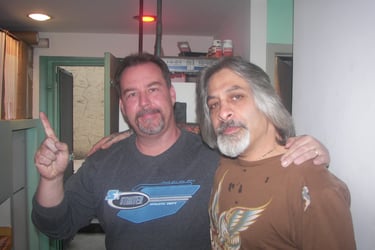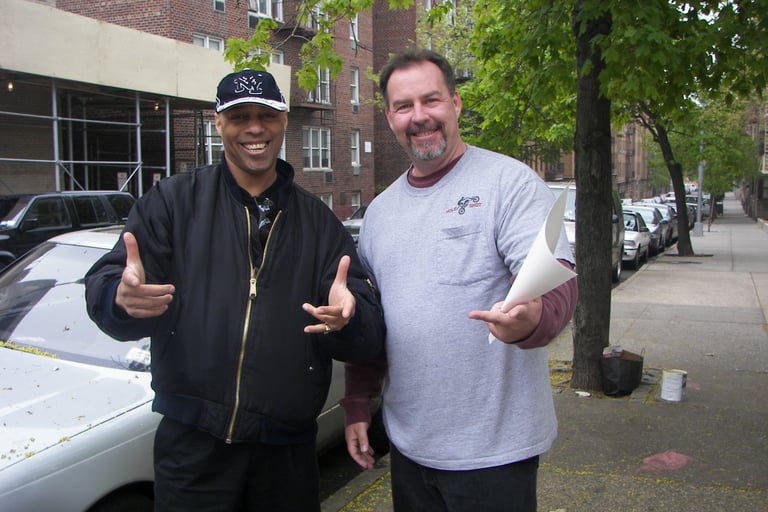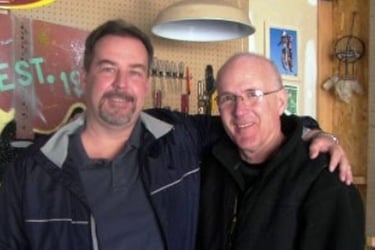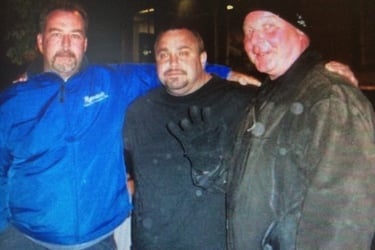
"Authentic Narratives,
Real Life: Non Fiction, No Frills, No Filler."
Born and raised in the Bronx, John F. Lorne came up fast in a rough world—absent father, single mother, and streets filled with hard lessons. He founded the Morris Park Crew (MPC), later featured in the 1983 PBS documentary Style Wars, and was active during the peak of New York’s graffiti movement.
Earlier in his life, he attended the Phoenix House Academy in NY and made appearances on the Phil Donahue Show and the Scared Straight Program at Rahway State Prison in 1978.
After years of drifting, John made a major life shift and moved to Santa Fe, NM, where he found purpose in family, small business, and public service. A surprise invitation into community mural work opened creative doors and eventually led to his role as creative art director for Warehouse 505 in Albuquerque.
Tragedy struck when his wife Heide passed from cancer after a string of medical failures. Her loss led to the raw and unflinching memoir Surviving Grief: A Prescription for Disaster, exposing the failings of a system where profit too often outweighs compassion.
Now remarried and raising a son, John continues to write from lived experience exploring topics like government dysfunction, second chances, fatherhood later in life, and real love across borders.
Whether it’s Letters to Mom or his next memoir, every story he tells comes from one place: truth.
Cut the BS. Life’s too short not to say what you mean.”
About John


I’m a family man, a loyal companion, and a lifelong believer in second chances. I’ve lived through grief, reinvention, and redemption—and I write about it all.
Motorcycles, soul-shaking music, raw art, and global adventures keep my fire lit.
I write to confront injustice, preserve memory, and remind people that truth still matters. My life — from the Bronx to government service, from loss to love, from faith to fatherhood — has given me a front-row seat to the best and worst of humanity. Through my books, I aim to speak for the people who live in the margins of the headlines — not as a politician, not as an academic, but as one man’s truth.
Legends & Visionaries
You don't forget the ones who shaped the movement.
This is more than shoutouts. These are the guys who left their mark on steel, walls, and history—and on me.
Seen. Blade. Cap. Henry. Each one played a role in my story, and in the story of graffiti.
These aren't just names—they're moments, memories, and missions that made the culture what it is.
Here’s my piece of that history.


SEEN
The Godfather of Graffiti
Seen was already making noise when we crossed paths—but one memory that always stuck was the night our two crews met in Westchester Square.
There was a hardware store we hit for paint, but it had this dog in the yard. Some were talking poison. We were trying to figure out how to move smart. Seen played it cool—got the paint, made sure the dog was safe, held it down. Years later, he sent me that memory for the book—because he remembered what he did that night.
And it goes deeper—his brother Mad, part of the original TNC crew, helped shape what later became the United Artists crew, which Seen led. They came down to our neighborhood to meet us—and that moment inspired me to form MPC.
The Morris Park Crew started with that energy—crew to crew, block to block, showing up and making your name mean something.


BLADE
The Crazy Five. The Visionary.
First time I met Blade I was about 13. Me and Colt broke night—out bombing trains like we did—and somehow ended up in the Esplanade Tunnel, where Blade was doing a whole car.
He had this little Boom Box radio on, playing “This is your night tonight, everything’s gonna be alright.” That stuck with me.
We sat on the third rail, just watching him work. No rush. No chaos. Just Blade, focused—painting like the train was a canvas in a museum.
When the sun came up, we all went over to the Pelham Parkway Diner for Cheese Burger deluxes . Still smelling like steel and paint.


HENRY CHALFANT
The Eye Who Saved the Movement
My connection with Henry goes way back—to the early days, hanging with Tracy 168, when writers first started moving from trains to canvas and into galleries.
Years later, around 2008, Henry showed up at my house in Rio Rancho, New Mexico, filming me for an Apple series about "Where Are They Now?" He told me straight:
“You gotta write a book about MPC. People always ask me about it.”
That conversation is what put me on the road to writing the Morris Park Crew book.
In 516 ARTS’ Street Text: Art from the Coasts, it was me, Henry, and Lady Pink repping New York. That show also featured names like Swoon—but it was Henry who anchored our side with history.
And almost every train flick in that MPC book? 95% of them came from Henry. I didn’t have those any shots . Without him, a big part of our legacy might’ve stayed undocumented.


CAP
The Outlaw. The Takeover.
Me and Cap go way back. He was brought into MPC by a writer named Kass, and when the first generation of us—myself, Colt, and a few others—stepped back from writing, Cap took over.
But he didn’t just carry the name—he flipped the whole identity. Cap went outlaw. Aggressive. Started crossing everybody out. The game changed after that.
There’s a moment in the Style Wars outtakes—he talks about going to the yard and crossing out Case2. That wasn’t just talk. I was there. It was me, Cap, Colt, and Kass—we were doing top-to-bottoms in the yard, and we came across Case’s train. Cap crossed it. All because of some beef from back at 149th Street—the Writer’s Bench.
Controversial? Yeah. But make no mistake—Cap made MPC feared, respected, hated, and known.
In the middle of that photo is Des—you might know him from Spraycan Art. He was military, quiet, good guy. Didn’t run with the drama like Cap, but he held his own.
2024 John F Lorne All Rights Reserved
